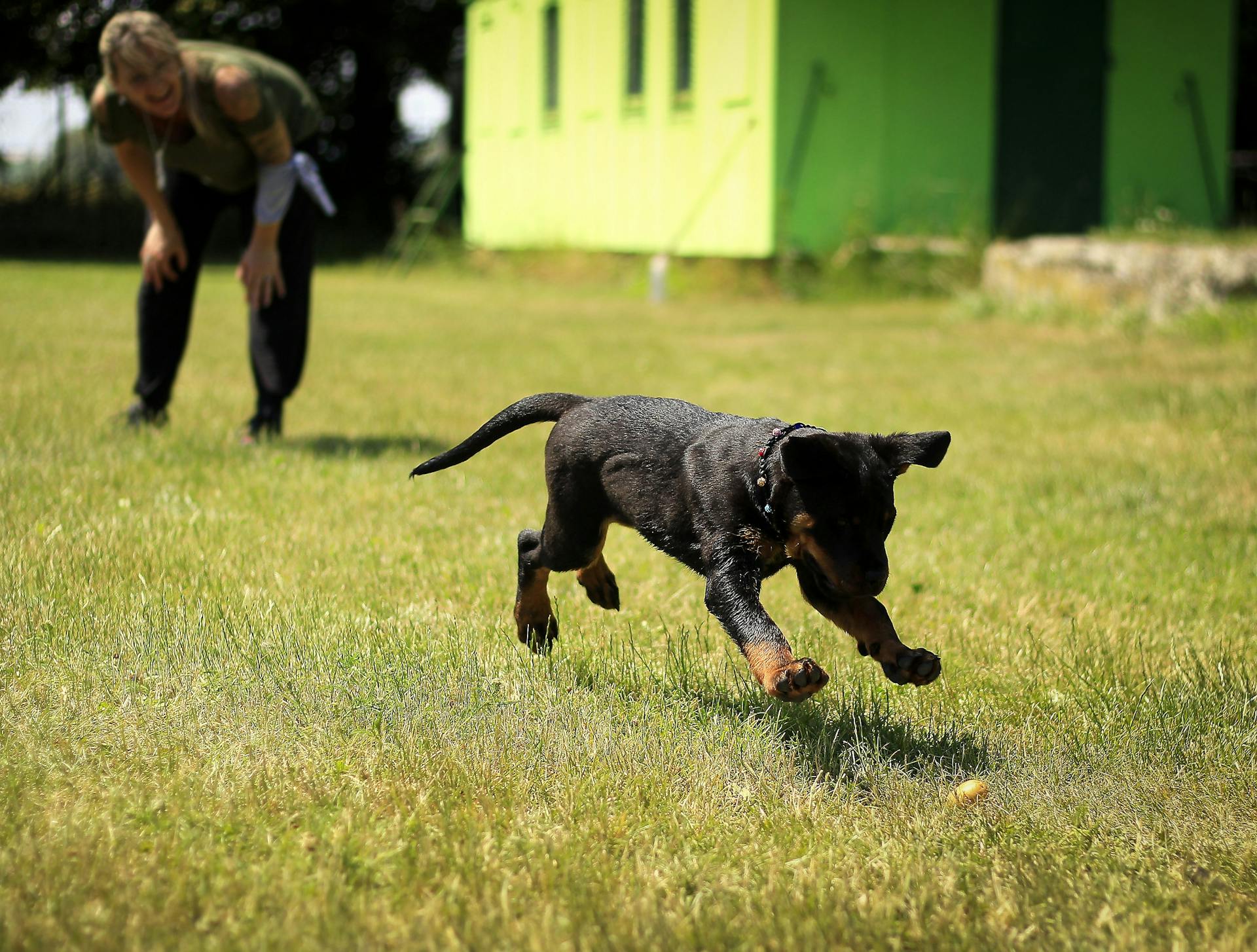
No, you typically cannot feel a microchip in a dog. Microchips can be as small as a grain of rice and are injected between the shoulder blades of your pet.
The microchip typically emits no sensations but is designed to store information that can be read by scanning it with an RFID reader. The type of information stored on the chip varies but usually contains the animal’s ID number, current owner details and a contact number so they can be identified in the event they become lost or stolen. Vets and some organizations such as the SPCA will often scan for chips so animals can be returned to their rightful owners promptly.
Most pets show very little discomfort when receiving their chip - if any at all - so aside from slight swelling or bruising at the injection site you won’t feel or notice anything different about your pet before, during or after its insertion. That being said, there is no harm in running your hand over their body,where the microchip was inserted, just to double-check if you do notice any unusual bumps beneath their fur!
How can you tell if a dog has a microchip?
Modern technology has made it possible to identify and keep track of our dogs in an incredibly effective way. One such technological advancement is the microchip, a tiny computer chip implanted in your dog beneath their skin. It's a method of identification that can help reunite you with your pet if they ever become lost or stolen, granting many pet owners peace of mind when it comes to their four-legged companions. But how do you know if your dog actually has one?
The easiest way to determine if your pup is chipped is by having them scanned at any vet office or animal shelter (some even offer free scanning). Veterinarians typically use handheld microchip scanners that contain a low-power RFID (radio frequency identification) reader capable of identifying most chips available in the United States. These scanners release radio waves which detect a specific embedded code manufactured into every microchip and then display the unique registration number on the device’s backlit LCD screen as soon as it detects it in your dog’s body.
If your pup isn’t already chipped, then you can easily have one inserted at any local vet or shelter with minimal discomfort — it's much like receiving a shot! So if you're looking for peace of mind where your furry friend is concerned, investing in microchipping could be just what you need!
Are microchips detectable under the skin of a dog?
The short answer to the question of whether or not microchips are detectable under the skin of a dog is yes. Microchips, which are also known as RFID chips or transponders, are inserted just beneath your dog’s skin between the shoulder blades in a quick and relatively painless procedure. Veterinarians typically use hypodermic needles to place the microchip.
Once placed under your pet’s skin, these tiny chips can easily be detected using either a handheld scanner that reads radio frequency identification (RFID) tags or an X-ray machine. This technology allows veterinarians and animal shelters to quickly access your pet’s information with just one scan, providing clear proof of ownership in case of theft or loss.
However, it will be important that you keep your pet's microchip registration details up-to-date so that all records can be synchronized and accurate information is readily available if needed. Take a few minutes every year or two to accurately update your contact information with the chip manufacturer in order to ensure that your pet’s information remains easily accessible should any questions arise about who owns them.
All in all, microchips can detect both healthy and sick pets because they remain undetected beneath their skin and offer quick access to important medical records should anything happen while they miss indoors, outdoors, at home or even on international adventures!
Is a microchip visible on a dog's body?
The answer to the question of whether or not a microchip is visible on a dog's body depends on the type of microchip being used. If the microchip is an external, visible chip, then yes, it will be visible and can be seen with the naked eye. Generally these types of chips are made up of different colored plastic pieces that are easily identifiable under short hair. However, if the microchip is an “invisible” chip — one that's inserted inside (subcutaneous) your dog's skin — then it won't be visible from physical observation alone. In order to detect this type of chip you would need to use a special scanner that emits radio waves and specifically looks for RFID chips implanted in animals.
It’s also important to highlight that regardless of whether or not you can physically see your pup’s chip –– all dogs should have their tag info updated annually for maximum protection against theft or loss. Getting a permanent identification microchip installed in your pet is always highly recommended and gives owners peace-of-mind knowing their furry family member has been permanently identified with their registered information accessible just by scanning them with any standard RFID reader out there!
How long does a microchip last in a dog?
When it comes to microchipping our furry friends, one of the most important questions many dog owners ask is: How long does a microchip last in a dog?
The answer isn't always straightforward, as the longevity of a microchip can depend on several factors—ranging from the frequency of checkups to weather conditions. On average, however, your pet's implant should last its entire lifespan.
Firstly, high-quality chips use passive Radio-Frequency Identification (RFID) technology and are usually encapsulated in an inert material so that your pup won’t experience any discomfort or allergies. It is also worth noting that all built-in sensors are designed to remain inactive until scanned by an RFID reader. This means that your pup won’t experience any undesired reactions once it has been chipped.
In some cases though, a chip might fall out or become dislocated once implanted under your pet's skin—a rare occurrence considering the medical grade materials used in production—forcing you to have another inserted in their place. Also keep in mind that extreme temperatures can affect its longevity as well; which is why these implants should be done during moderate climates and not during excessively hot/cold days.
But as with every other medical caregiver for pets (euthanasia being an obvious exception), having regular checkups is essential for making sure your pup's microchip continues functioning properly; thus avoiding any potential complications due to damaged components such as decreased signal strength or damaged antennae connections before they become noticeable over time. Most importantly though: integrating those reminders into everyday life will help prepare both you and Fido if you ever need to quickly find him/her!
Are there any risks associated with implanting a microchip in a dog?
Implanting a microchip in a dog can offer pet owners peace of mind and the ability to locate a lost pup, but there are risks that need to be considered. First, the microchip itself is inserted into the upper layer of skin and may cause discomfort or infection if not inserted properly by an experienced professional. Proper hygiene between insertion sites needs to be practiced as well. Second, while all data related to pet owners is encrypted, there is always potential for hacking or third parties obtaining information without permission - so it's important to understand your rights related to this technology before having a chip implanted in your pup. Thirdly, health issues can stem from improperly administered implants that may lead to vet bills and possibly damaged chips reducing their effectiveness. Finally, because many modern microchips require external scanners for proper operation, it's important that these scanners are up-to-date as older versions may not recognize certain types of chips resulting in inaccurate data results which could put your pup at greater risk of being lost or stolen if you don't have updated tracking information available on them at all times.
All things considered though microchipping pets can offer tremendous benefits when done correctly and responsibly with the appropriate scanning devices readily available should the need arise. With careful consideration given before opting into such technology and regular maintenance checks afterwards it seems quite likely this particular advancement will continue offering pet owners great piece of mind in regards what fate their 4-legged family members might otherwise face without them being around when they're needed most - whatever they happen to be doing where ever they happen to go!
Sources
- https://corporate.discovery.com/discovery-newsroom/
- https://www.telegraph.co.uk/news/
- https://www.nationalgeographic.com/magazine/
- https://www.telegraph.co.uk/lifestyle/
- https://www.wikihow.com/Tell-if-a-Dog-Is-Microchipped
- https://app.criticalmention.com/app/
- https://www.lowcostpetvaccinations.net/
- https://www.petdoors.com/collections/electronic-automatic-microchip
- https://www.thetimes.co.uk/
- https://www.eurogamer.net/playstation-userbase-significantly-larger-than-xbox-even-if-every-cod-player-ditched-sony-microsoft-says
- https://www.preventivevet.com/dogs/how-to-update-your-pets-microchip
- https://www.nola.com/entertainment_life/get-pets-microchipped-now-so-theyre-home-for-the-holidays/article_f3944d9c-72a4-11ed-8bd2-7fa12634e571.html
- https://www.theverge.com/2022/10/19/23411972/microsoft-xbox-mobile-store-games
- https://vegweb.com/
- https://www.microchip.com/en-us/products/clock-and-timing/components/mems-timing
Featured Images: pexels.com


